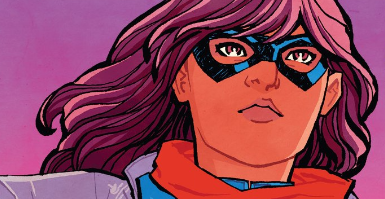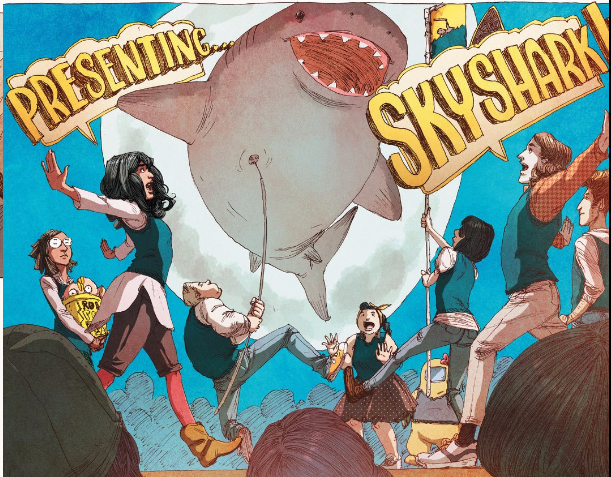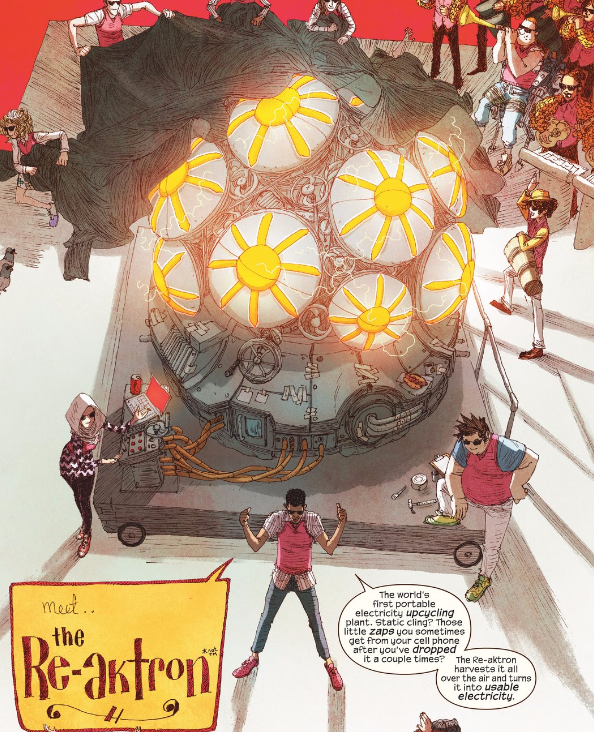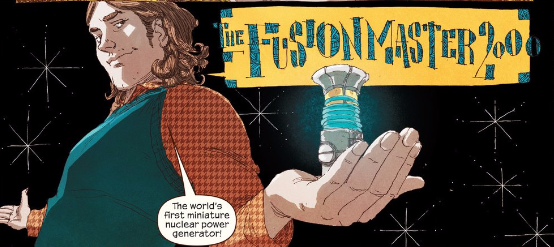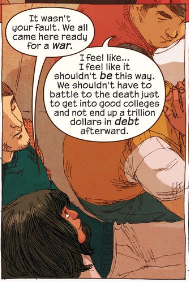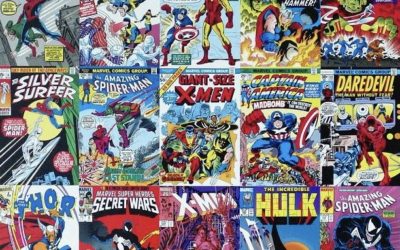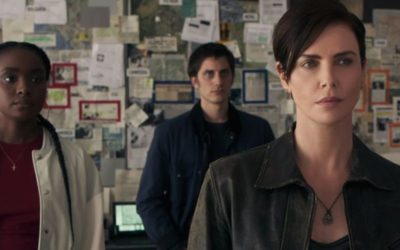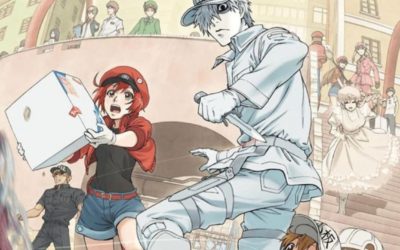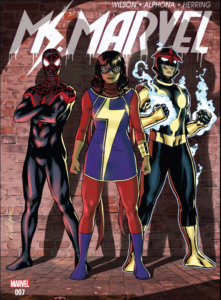 Can we talk about Ms. Marvel for a second? Oh, and science fairs, but we’ll hit Ms. Marvel first.
Can we talk about Ms. Marvel for a second? Oh, and science fairs, but we’ll hit Ms. Marvel first.
You know, the comic published by Marvel starring Kamala Khan, a Jersey City teenager who received polymorph powers (she can make herself big or small, and every size and shape in between…) thanks to the Terrigen Mist (yeah – that Terrigen Mist of the Inhumans side of the Marvel Universe that is also a major plot-driver on Marvel’s Agents of SHIELD on ABC).
Ms. Marvel has been in the headlines many times thanks to the fact that she’s a teenage girl, she’s of Pakistani origin and also Muslim. The character was created by Marvel editors Sana Amanat and Steve Wacker, and her series is written by G. Willow Wilson, with Adrian Alphona on art. To say that the series is acclaimed is an understatement. Ms. Marvel (which is currently in its second series due to restarts and…don’t ask…it’s comics) is one of Marvel’s current crop of critical hits – winning Eisner, Harvey and Hugo awards in 2015 and the Prize for a Series this year at the Angouleme International Comics Festival in France. Amanat, who infused some of her own experiences growing up in Jersey City into the character, has spoken about Ms. Marvel many times – in early May on the Today Show for example, as well as at TEDx Teen in 2014. Heck, she even presented President Obama with a Ms. Marvel hardcover.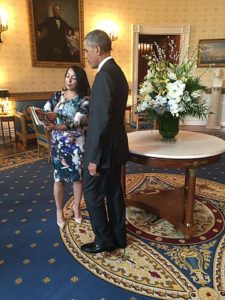
What we’re saying here is that Ms. Marvel is a popular comic book for a lot of reasons. But one of the things we love about Ms. Marvel rarely gets covered by the larger media – the characters’ and the series unabashed love of science and STEM topics.
Just in the current volume there have been a ton of callouts to science and STEM – Kamala is regularly shown in, or talking about science classes at school (that she likes! I know, right? Popular culture showing a teenage girl liking science! And she’s good at it too!), her friends dig science as well as other classes (that is, they’re not shown as stereotypical “nerds”), and in more than a few cases, Kamala has realized that her science smarts – or those of her friends – were the only way to solve a problem. Oh, and she occasionally picks up homework help in physics from Tony Stark…or tries to. She is an Avenger, after all.
But with this month’s Ms. Marvel #7 (still on shelves at your local comic shop or for sale digitally at Comixology.com), Wilson and Alphona have knocked the science ball out of the park. The issue’s story is set at Madison Square Garden, the home of the Tri-State Ultra Mega Science Fair, where high school science students from the Tri-State are come to compete for prizes, and more importantly, in Kamala’s eyes, scholarship money for college. Even in comics, the pressure to do well in school and get into a top college are real.
The storyline sets up the rivalry between Kamala and her classmates from Jersey City and the competitors from New York, which includes the “brain from Brooklyn,” Miles Morales – who Kamala knows is Spider-Man, a teammate and good friend on her Avengers team (Miles doesn’t know Kamala is Ms. Marvel, though – read the series for the explanations on that one). Connecticut’s team isn’t shown, although it’s said they’ll probably try to get Jersey City’s entry disqualified on a technicality because “This is what happens when you live in a state that’s, like, 80 percent lawyers,” according to Kamala’s friend, Bruno.
The issue perfectly captures the optimism and enthusiasm of good science fairs along with the rivalry between teen groups.
Jersey City opens with Skyshark…(don’t worry – it’s not cruel for the shark – he’s a rescue shark and the happiest shark there is)
Which is countered by New York’s Re-aktron, which harvests all the electricity floating around in the air…
Which Jersey City counters with the Fusionmaster 200, a pocket sized fusion reactor (although, to be a little picky, the comments about the Fusionmaster made by the judge, Bruno and Miles are talking about fission, not fusion.)
The Tri-State Ultra Mega Science Fair ends as all science fairs in movies, television and comics tend to, allowing the characters of both teams to make friends and offer up some spot-on commentary about education.
All in all, there’s very little “costume time” in this issue, and a whole lot of character moments and storytelling built around the science fair, which is cool.
The depiction of the Tri-State Ultra Mega Science Fair in Ms. Marvel is something that Wired’s Rhett Allain would certainly agree with. In February, writing for Wired, Allain (an Associate Professor of Physics at Southeastern Louisiana University) outlined some of the problems he saw at a local science fair that seem to be endemic to all but the highest of high-profile science fairs. In far too many instances, science fairs have become required parts of the curriculum, and as any teacher or parent will tell you, the best way to murder enthusiasm for a topic is to make it required. Enthusiasm, curiosity and passion should drive science fairs, not participation grades.
Here’s Allain with his thoughts on what he saw:
Allain’s suggestions to make science fairs better? A fairly simple list (more details can be found in the Wired article)
1) Be more flexible. There is not a one size fits all for every science project. Don’t force students to use a cookie-cutter format.
2) Reward creativity. It’s not too difficult for a student to find a project online and replicate it. There is some value to repeating what others have done, but you should be clear about it. Some of the best science fair projects start small and aren’t always successful—but they are driven by the student, not the Internet.
3) What about a MythBusters style science fair? Instead of “my hypothesis was confirmed”, students could just use “busted”, “confirmed”, “plausible”. But are the MythBusters even scientists? Yes, all humans are scientists.
4) Don’t make it a competition. Do you have to have a winner? Is this the Super Bowl? No. How about we make it like a Maker Faire? Students could get together to share their projects. Sure, you could still give out prizes and rewards for creativity or best graph or whatever—just don’t focus on the competition aspect.
5) Don’t make it mandatory. I can tell some of these students just don’t want to be there. What if we made every student enter an art competition? Would that make them like art more? No, I don’t think so either.
These are all great ideas that could be embraced by both students and teachers alike.
And we couldn’t talk about science fairs without a nod of thanks and respect to President Obama who has hosted the White House Science Fair for six years. Look – say what you will about the President on any variety of topics, but let us have this topic. Through the six White House Science Fairs, Obama demonstrated that science is important, and moreover, getting younger generations interested and enthused about science is one of the best things that older generations can do – for all the generations of people on the earth. Taking the day to be an unabashed science enthusiast, Obama has called the days of the Science Fairs at the White House, “the most fun day of the year.”
Thanks to Ms. Marvel for pointing the fun and potential of science fairs as well.
Oh, hey – and if you’re a teacher, science or otherwise, collections of Ms. Marvel would be great additions to your school’s media center or great additions for your own classroom library.


